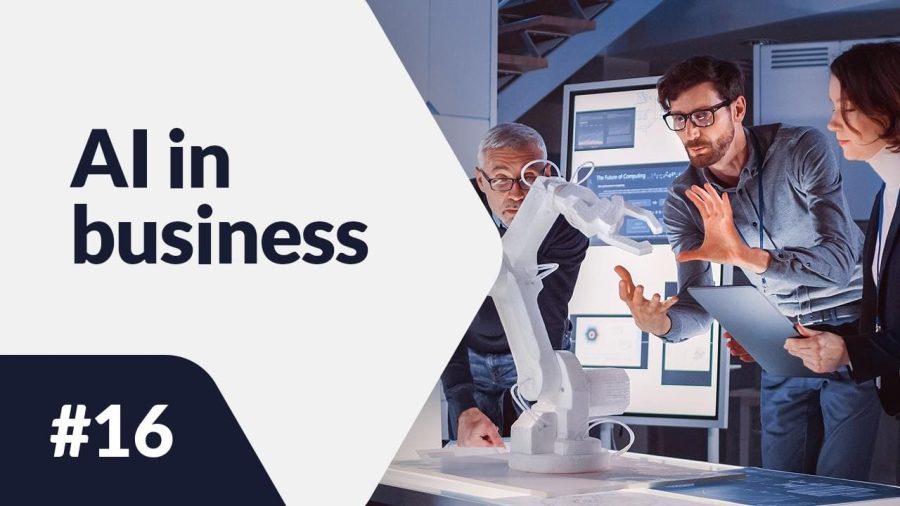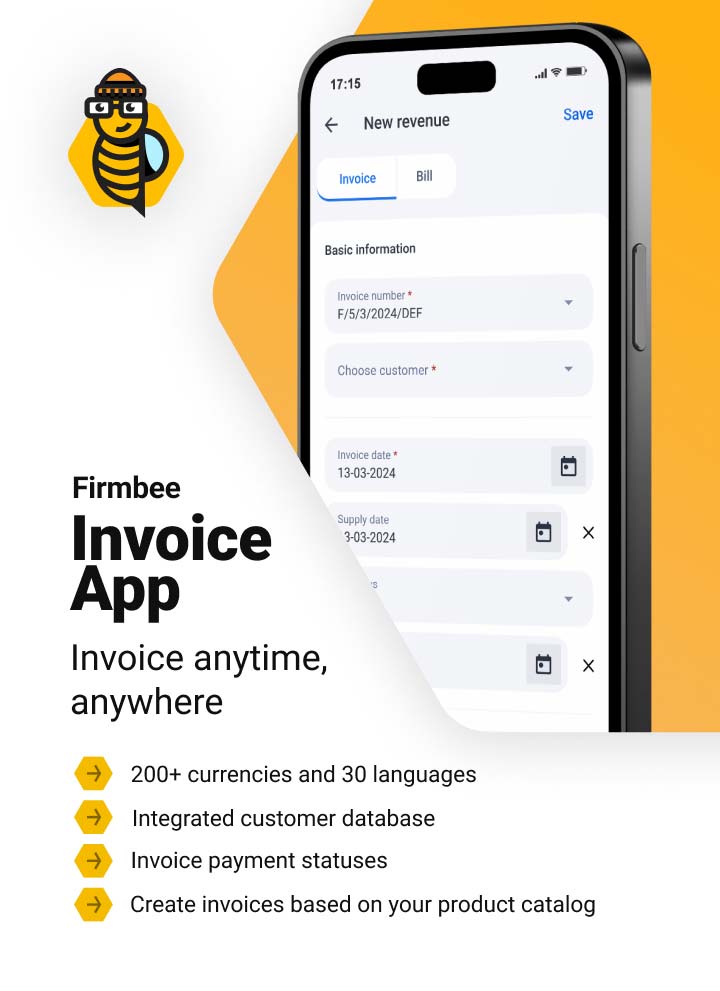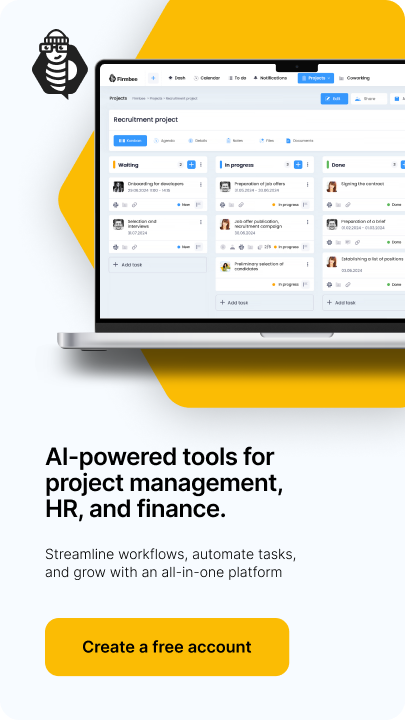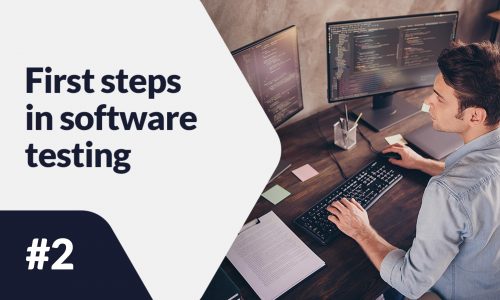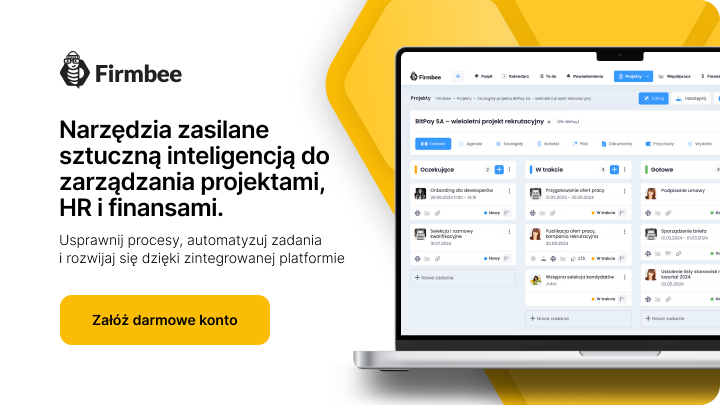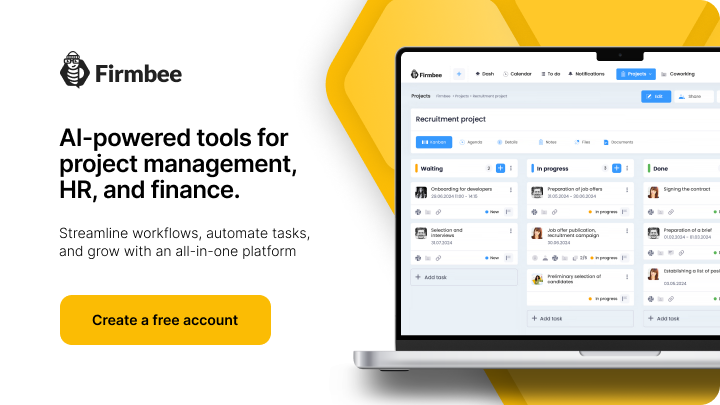In the world where data is becoming the new currency, business intelligence (BI) tools are key. But is inserting artificial intelligence (AI) into the equation a necessity or just a fashionable addition? Let’s dive into the world of BI tools to understand how AI can enrich them.
Business intelligence - table of contents
What is business intelligence?
Business Intelligence is not just the process of transforming raw data into valuable information. It is the bridge that connects data with decisions, enabling companies to better understand the market, the competition and their operations. The key elements of Business Intelligence are:
- Data – a raw material that is processed and analyzed to become information.
- Information – properly interpreted and placed in context,
- Knowledge-based on data and information, is the key to making sound business decisions.
The 3 most popular business intelligence tools
Let’s take a look at the most popular tools that improve the transition from data to AI-assisted knowledge.
- Tableau – a platform that employs artificial intelligence to help users create interactive reports and dashboards. Tableau’s most interesting features include:
- Ask Data – to ask questions in natural language, and Tableau provides the answers in the form of visualizations,
- Explain Data – helps understand what’s behind the data, explaining anomalies and trends,
- Smart Recommendations – suggests the best ways to visualize data, combine data sources and create calculations,
- Einstein Discovery – allows you to quickly create and implement advanced predictive models and present their results in Tableau.
- Microsoft Power BI – offers a rich set of AI components to easily and quickly enrich your data with pre-built or custom machine learning models. Microsoft Power BI features based on artificial intelligence are called AI Insights, which include:
- Text Analytics – enables analysis of emotions in processed text, extraction of key phrases, language detection and proper name recognition. It can therefore examine customer feedback, automatically understand key topics from product reviews, detect the language of emails, or identify names of people, organizations and places from newspaper articles,
- Vision – it can automatically tag images and segregate them with labels that describe the image content. It can, among other things, classify product photos, tag landscape or animal photos, recognize faces or logos, or generate captions to describe scenes in images,
- Oracle BI – a comprehensive solution that features AI components, in areas:
- generative AI – to create new content based on existing data, such as reports or presentations,
- predictive tasks – to forecast future behavior, performance and trends based on historical and current data. For example, Oracle BI can forecast demand, sales, profitability, risk, customer loyalty and many other business metrics using built-in or custom analytical models,
- responsible AI – to build confidence in data analytics through procedural transparency. This Oracle BI component is designed to help users understand the logic and provide justifications for AI recommendations, monitor the performance and accuracy of analytical models, detect and eliminate biases and discrimination in data and algorithms, and collaborate with other users and experts to improve the quality and value of business information.
Tableau also integrates with multiple platforms, such as Salesforce, Google Cloud, and Amazon Web Services (AWS), making it a flexible and versatile solution for businesses.
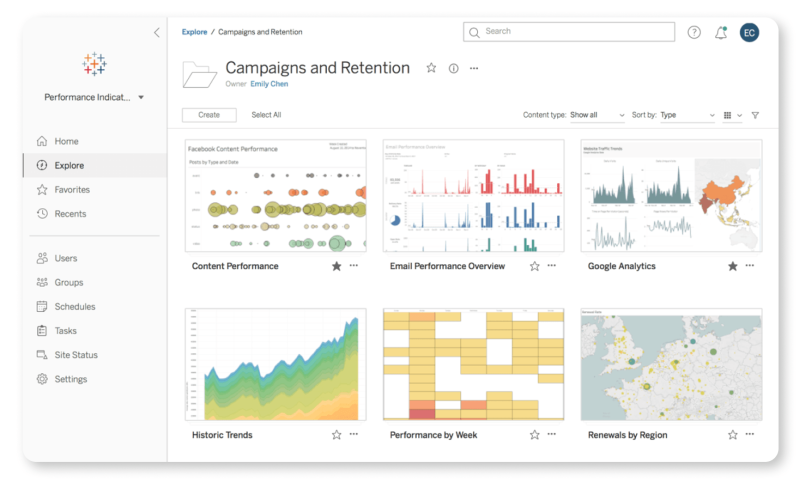
Data visualization in Tableau.
Source: Tableau.com
Power BI is integrated with Azure, enabling advanced analytical models and cloud functions.
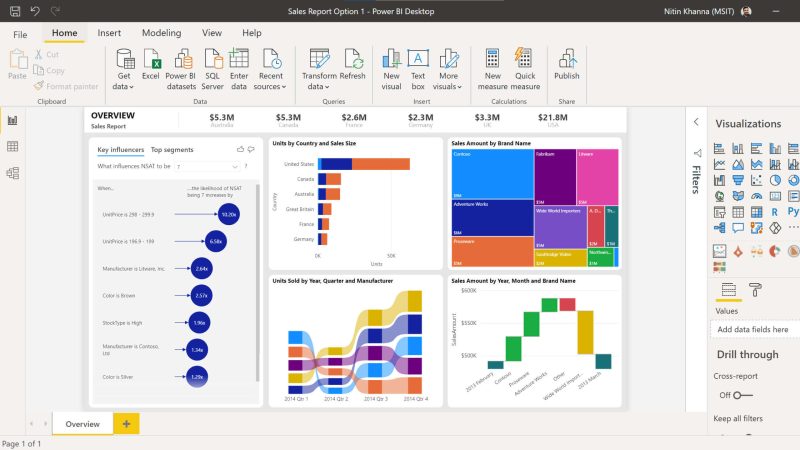
Data Visualization in Microsoft Power BI.
Source: powerbi.microsoft.com
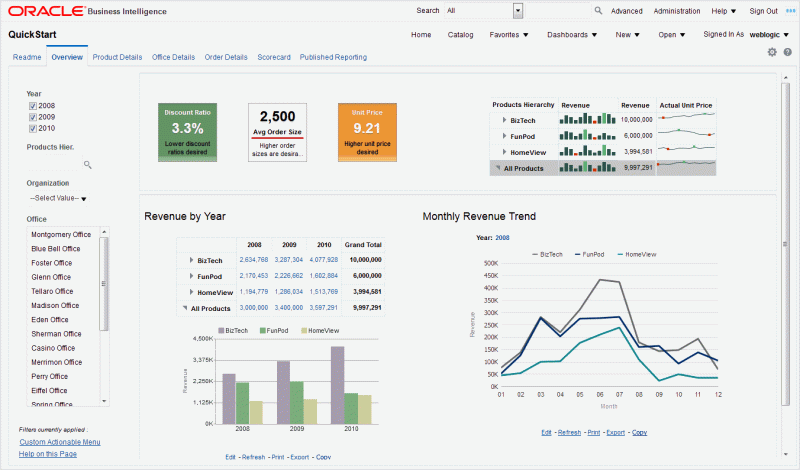
Data Visualization in Oracle Business Intelligence.
Source: docs.oracle.com
BI vs AI – differences and example applications
While business intelligence focuses on analyzing data, artificial intelligence adds the ability to draw conclusions and make decisions on its own to the equation.
BI (business intelligence) is a term that refers to various tools and techniques for collecting, integrating, analyzing and presenting business information. The goal of business intelligence is to support better decision-making by providing accurate, timely and relevant information.
AI (artificial intelligence), on the other hand, deals with tasks that require natural language understanding, image recognition or decision-making.
Here are three key differences between BI and AI:
- Goal: Business intelligence aims to support better decision-making by providing accurate and timely information, while AI’s goal is to automate tasks that require human intelligence.
- Technologies: BI has a variety of tools and techniques to collect, integrate and analyze data, while AI features advanced machine learning and deep learning algorithms to create computer systems capable of performing complex tasks.
- Scope: Business intelligence focuses on analyzing business data and providing decision-support information, while AI can be applied to a wide variety of areas, including supporting BI operations and drawing conclusions from data.
For example, BI collects and analyzes data on customer buying behavior, while AI allows you to create a system that recommends products to customers based on analysis of their buying behavior. It seems that what they have in common is mainly the word “intelligence.”
Perspectives on AI-supported business intelligence
Artificial intelligence not only enriches BI tools but also opens up new possibilities. Thanks to AI, BI systems can:
- better understand the needs of users,
- provide more precise forecasts and
- automatically adapt to changing market conditions.
In the future, we can expect even more integration of business intelligence with AI, which will bring new opportunities and challenges for businesses. AI can enable the automation of many analytical tasks, for example, it can be used to:
- automatic input cleaning,
- the creation of statistical models or machine learning, as well as
- generating visualizations and reports.
AI can also help discover new patterns and relationships in data that might be overlooked by humans. This will help companies gain new insights into their operations and make better business decisions.
BPM, business analytics and AI-enabled BI – what’s the difference?
BPM focuses on managing and improving business processes, while business analytics tools analyze data and provide insights into business performance. BI encompasses both areas and relies on various tools and techniques to support better decision-making. Despite some overlapping between these areas, each has its focus and set of tools:
- BPM (Business Process Management) is a discipline that deals with managing and improving business processes in an organization. BPM tools help to design, model, execute, monitor and optimize business processes to increase efficiency and effectiveness.
- Business analytics tools are used to analyze data and provide insights into business performance. These include data mining, predictive analytics and statistical analysis tools. Business analytics tools help to identify trends, patterns and relationships in data to support decision-making.
- Business intelligence (BI) is a broader term that includes both BPM and business analytics. BI involves combining various tools and techniques to collect, integrate, analyze and present business information. The goal of BI is to support better decision-making by providing accurate, timely and relevant information.

Does BI need artificial intelligence?
In the era of digital transformation, while operating on big data, the combination of business intelligence with artificial intelligence is becoming indispensable. Tools such as Tableau, Power BI and Oracle BI show how powerful this blend of technologies has become, providing companies with tools that help them make better business decisions.
However, does BI need artificial intelligence? This is a question with no clear answer. On the one hand, artificial intelligence can help analyze and interpret large data sets, providing valuable information and guidance to decision-makers. On the other, it can get costly, complex and prone to error or manipulation.
In the future, we can expect even more integration of BI with AI, which will bring new opportunities and challenges for businesses. In a world where data is the key to success, the responsible combination of BI and AI is becoming a really important issue.
If you like our content, join our busy bees community on Facebook, Twitter, LinkedIn, Instagram, YouTube, Pinterest.
Author: Robert Whitney
JavaScript expert and instructor who coaches IT departments. His main goal is to up-level team productivity by teaching others how to effectively cooperate while coding.
AI in business:
- Threats and opportunities of AI in business (part 1)
- Threats and opportunities of AI in business (part 2)
- AI applications in business - overview
- AI-assisted text chatbots
- Business NLP today and tomorrow
- The role of AI in business decision-making
- Scheduling social media posts. How can AI help?
- Automated social media posts
- New services and products operating with AI
- What are the weaknesses of my business idea? A brainstorming session with ChatGPT
- Using ChatGPT in business
- Synthetic actors. Top 3 AI video generators
- 3 useful AI graphic design tools. Generative AI in business
- 3 awesome AI writers you must try out today
- Exploring the power of AI in music creation
- Navigating new business opportunities with ChatGPT-4
- AI tools for the manager
- 6 awesome ChatGTP plugins that will make your life easier
- 3 grafików AI. Generatywna sztuczna inteligencja dla biznesu
- What is the future of AI according to McKinsey Global Institute?
- Artificial intelligence in business - Introduction
- What is NLP, or natural language processing in business
- Automatic document processing
- Google Translate vs DeepL. 5 applications of machine translation for business
- The operation and business applications of voicebots
- Virtual assistant technology, or how to talk to AI?
- What is Business Intelligence?
- Will artificial intelligence replace business analysts?
- How can artificial intelligence help with BPM?
- AI and social media – what do they say about us?
- Artificial intelligence in content management
- Creative AI of today and tomorrow
- Multimodal AI and its applications in business
- New interactions. How is AI changing the way we operate devices?
- RPA and APIs in a digital company
- The future job market and upcoming professions
- AI in EdTech. 3 examples of companies that used the potential of artificial intelligence
- Artificial intelligence and the environment. 3 AI solutions to help you build a sustainable business
- AI content detectors. Are they worth it?
- ChatGPT vs Bard vs Bing. Which AI chatbot is leading the race?
- Is chatbot AI a competitor to Google search?
- Effective ChatGPT Prompts for HR and Recruitment
- Prompt engineering. What does a prompt engineer do?
- AI Mockup generator. Top 4 tools
- AI and what else? Top technology trends for business in 2024
- AI and business ethics. Why you should invest in ethical solutions
- Meta AI. What should you know about Facebook and Instagram's AI-supported features?
- AI regulation. What do you need to know as an entrepreneur?
- 5 new uses of AI in business
- AI products and projects - how are they different from others?
- AI-assisted process automation. Where to start?
- How do you match an AI solution to a business problem?
- AI as an expert on your team
- AI team vs. division of roles
- How to choose a career field in AI?
- Is it always worth it to add artificial intelligence to the product development process?
- AI in HR: How recruitment automation affects HR and team development
- 6 most interesting AI tools in 2023
- 6 biggest business mishaps caused by AI
- What is the company's AI maturity analysis?
- AI for B2B personalization
- ChatGPT use cases. 18 examples of how to improve your business with ChatGPT in 2024
- Microlearning. A quick way to get new skills
- The most interesting AI implementations in companies in 2024
- What do artificial intelligence specialists do?
- What challenges does the AI project bring?
- Top 8 AI tools for business in 2024
- AI in CRM. What does AI change in CRM tools?
- The UE AI Act. How does Europe regulate the use of artificial intelligence
- Sora. How will realistic videos from OpenAI change business?
- Top 7 AI website builders
- No-code tools and AI innovations
- How much does using AI increase the productivity of your team?
- How to use ChatGTP for market research?
- How to broaden the reach of your AI marketing campaign?
- "We are all developers". How can citizen developers help your company?
- AI in transportation and logistics
- What business pain points can AI fix?
- Artificial intelligence in the media
- AI in banking and finance. Stripe, Monzo, and Grab
- AI in the travel industry
- How AI is fostering the birth of new technologies
- The revolution of AI in social media
- AI in e-commerce. Overview of global leaders
- Top 4 AI image creation tools
- Top 5 AI tools for data analysis
- AI strategy in your company - how to build it?
- Best AI courses – 6 awesome recommendations
- Optimizing social media listening with AI tools
- IoT + AI, or how to reduce energy costs in a company
- AI in logistics. 5 best tools
- GPT Store – an overview of the most interesting GPTs for business
- LLM, GPT, RAG... What do AI acronyms mean?
- AI robots – the future or present of business?
- What is the cost of implementing AI in a company?
- How can AI help in a freelancer’s career?
- Automating work and increasing productivity. A guide to AI for freelancers
- AI for startups – best tools
- Building a website with AI
- OpenAI, Midjourney, Anthropic, Hugging Face. Who is who in the world of AI?
- Eleven Labs and what else? The most promising AI startups
- Synthetic data and its importance for the development of your business
- Top AI search engines. Where to look for AI tools?
- Video AI. The latest AI video generators
- AI for managers. How AI can make your job easier
- What’s new in Google Gemini? Everything you need to know
- AI in Poland. Companies, meetings, and conferences
- AI calendar. How to optimize your time in a company?
- AI and the future of work. How to prepare your business for change?
- AI voice cloning for business. How to create personalized voice messages with AI?
- Fact-checking and AI hallucinations
- AI in recruitment – developing recruitment materials step-by-step
- Midjourney v6. Innovations in AI image generation
- AI in SMEs. How can SMEs compete with giants using AI?
- How is AI changing influencer marketing?
- Is AI really a threat to developers? Devin and Microsoft AutoDev
- AI chatbots for e-commerce. Case studies
- Best AI chatbots for ecommerce. Platforms
- How to stay on top of what's going on in the AI world?
- Taming AI. How to take the first steps to apply AI in your business?
- Perplexity, Bing Copilot, or You.com? Comparing AI search engines
- ReALM. A groundbreaking language model from Apple?
- AI experts in Poland
- Google Genie — a generative AI model that creates fully interactive worlds from images
- Automation or augmentation? Two approaches to AI in a company
- LLMOps, or how to effectively manage language models in an organization
- AI video generation. New horizons in video content production for businesses
- Best AI transcription tools. How to transform long recordings into concise summaries?
- Sentiment analysis with AI. How does it help drive change in business?
- The role of AI in content moderation
